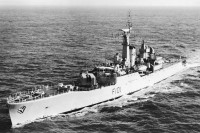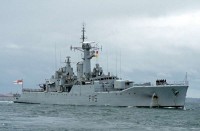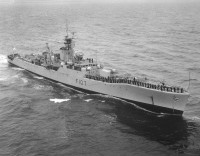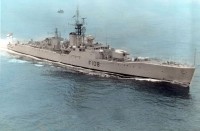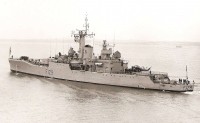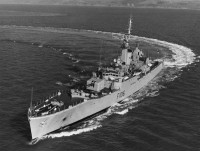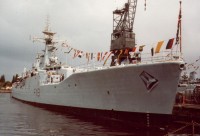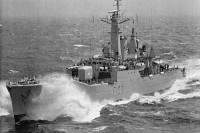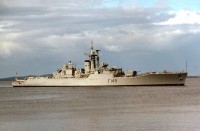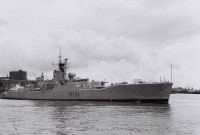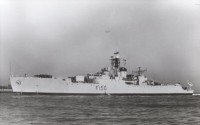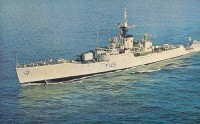Rothesay-class frigate (Type 12M frigates)
Basic information
Ship measurements
Machine
- 2 * Babcock & Wilcox boilers
- 2 * English Electric steam turbines
- 2 * shafts
- 30,000 shp (22,000 kW)
Personnel
Combat assets
As build:
- Radar Type 293Q target indication
- Radar Type 275 fire control on director Mark 6M
- Radar Type 277Q height finder
- Radar Type 974 navigation
- Type 1010 Cossor Mark 10 IFF
- Sonar Type 174 search
- Sonar Type 162 target classification
- Sonar Type 170 attack
As modified:
- Radar Type 993 target indication
- Radar Type 903 fire control on director MRS3
- Radar Type 978 navigation
- Type 1010 Cossor Mark 10 IFF
- Sonar Type 177 search
- Sonar Type 162 target classification
- Sonar Type 170 attack
As build:
- 1 * twin 4.5in gun Mark 6
- 1 * 40 mm Bofors gun Mark 7
- 2 * Limbo anti-submarine mortar Mark 10
- 12 * 21-in anti-submarine torpedo tubes (removed or never installed)
As modified:
- 1 * twin 4.5in gun Mark 6
- 1 * Sea Cat GWS-20 SAM
- 2 * 20 mm Oerlikon guns
- 1 * Limbo anti-submarine mortar Mark 10
- 2 * 8-barrel 3in Knebworth/Corvus countermeasures launchers
As modified: 1 * Westland Wasp HAS.1 MATCH helicopter
The Rothesay class, or Type 12M frigates were a class of frigates serving with the Royal Navy, South African Navy (where they were called President-class frigates) and the Royal New Zealand Navy.
The original Type 12 frigates, the Whitby class, were designed as first-rate ocean-going convoy escorts in the light of experience gained during World War II. However, such were the capabilities and potential of the design that it was deemed suitable for use as a fast fleet anti-submarine warfare escort. As such, a repeat and improved Type 12 design was prepared, known as the Type 12M (M for «modified») and called the Rothesay class after the lead ship. A total of fourteen vessels were constructed, with the lead ship being laid down in 1956, two years after the last Whitby. The design was successful and popular, serving the Royal Navy and South African Navy well into the 1980s, and serving with distinction in the Falklands War.
Design
The Type 12M retained the hull design of the Type 12, that allowed high cruising speed to be maintained in heavy seas, critical to the success of anti-submarine warfare in the era of the threat of the high-speed Soviet submarine. Armament and the propulsion plant remained largely unchanged. The main external differences were an enlarged raked and streamlined funnel (retroactively fitted to the Whitbys) and a modified after deckhouse, enlarged to carry the Sea Cat anti-aircraft missile launcher and its associated GWS-20 director and handling rooms as it became available. This weapon was not available at the time the first ships in class were completed, and either a twin Bofors 40 mm gun in a STAAG (Stabilised Tachymetric Anti-Aircraft Gun) mounting (Rothesay) or a single Bofors 40 mm gun on a Mk.7 mount was shipped in lieu. The arrangement of the torpedo tubes was also altered in the new design, with four fixed tubes firing aft at 45° on each beam, in front of a trainable twin mounting; the reverse of the arrangement on the Whitbys. A suitable weapon was never developed for these tubes, so they remained unused, or were never fitted. Internally, electrical generation capacity was increased to handle the increasing demands created by improved ship electronics. Accommodation standards were also improved, with partial bunking and air conditioning. Such was the success of the Rothesay design that it was elaborated into the excellent general purpose Leander-class frigate, the Type 12I.
Modification
Increasing submarine performance in the 1960s demanded detection and engagement of targets at a greater distance from the fleet. Detection was improved with new sonar designs such as the Type 177 search and Type 199 Variable depth. To attack targets at a greater range, the Royal Navy adopted the MATCH (Medium-range Anti-submarine Torpedo Carrying Helicopter) system. MATCH was essentially the Westland Wasp HAS.1, a lightweight navalised Westland Scout helicopter small enough to operate from the small hangar and flight deck that could be fitted to contemporary frigate designs, yet large enough to carry a pair of anti-submarine homing torpedoes (US Mark 44 or 46 types), allowing engagement of underwater targets at some distance from the parent vessel, outside the range of the shipboard Limbo anti-submarine mortars. To allow MATCH to be carried, all of the Type 12M class were modified and modernised, beginning with Rothesay from 1966 and finishing in 1972.
The after superstructure was removed, along with the foremost Limbo mortar, with the well being plated over to create a small flight deck. A small hangar was constructed in front of this, on top of which the GWS-20 Sea Cat missile and director was (finally) shipped. The mainmast was replaced by an enclosed design, carrying the Type 1010 IFF antennas, and the funnel height was increased to carry the hot exhaust gasses over the taller superstructure. The electronics fit was also upgraded from the World War II era sets fitted in the Whitbys. A large, enclosed foremast replaced the short lattice, carrying the distinctive «quarter cheese» antennas associated with the Type 993 target indicator. The Mark 6M director was replaced with the MRS3 Mod 3 system carrying radar Type 903, the later more automated and compact 1967–73 version of MRS3 using transistor electronics and analogue computers allowing the removal of the Type 277Q height finder. Additionally, Knebworth/Corvus 3-inch countermeasures launchers were fitted on either side of the bridge, as were a pair of World War II vintage 20 mm Oerlikon guns for «policing» work (and strictly limited anti-aircraft defence).
The extensive modifications of the Rothesays brought their armament and anti submarine capabilities into line with that of the original Leander-class vessels. However the last four Leanders had Doppler full spectrum 184 sonar which gave a clearer faster-read sonar, and all the Leanders originally had long range air warning and AD capabilities and communication decks, while the Rothesays remained specialised anti submarine frigates to perform better at that single purpose. In 1978, Rothesay went into refit for two years at a cost of 33.4 million pounds Yarmouth and Plymouth completed similar refits in 1981, which included fitting 994 short range warning radar and target indicator essentially (Plessy AWS1) in the old antenna, giving faster screen data in the Rothesays' operations room. This recent refit and marginally better radar resulted in their useful despatch for use in the Falklands War. It was planned to refit Rhyl, Brighton, Berwick and Falmouth with the very long range 2031 passive towed arrays which could listen for Soviet subs at ranges of 100 miles (160 km) plus. However union strikes, allegedly inspired by Communist activists, made it impossible to supply the equipment, possibly indicating how much the Soviets feared the potential of Type 12s with quiet steam plant and quiet hull sonars to run fairly fast and listen in the Arctic. In the immediate aftermath of the Falklands War Berwick and Falmouth twice deployed south for post-war patrols in 1982–83, probably ending plans to refit them as towed array frigates, as well as sister ship Rhyl which suffered mechanical failure when ordered south, and Brighton which was scrapped following the Nott Defence Review and never transferred to the standby force.
Ships14
- Comments
 en
en ru
ru uk
uk
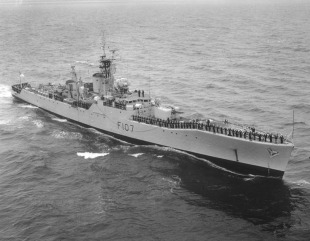
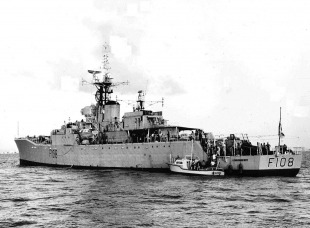
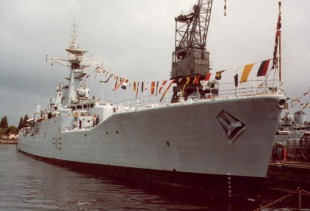
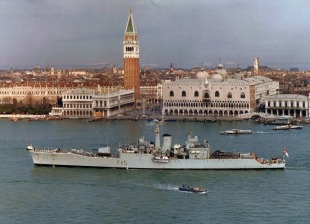
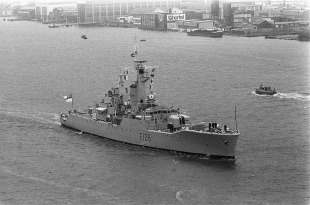

 Royal New Zealand Navy
Royal New Zealand Navy South African Navy
South African Navy Royal Navy
Royal Navy